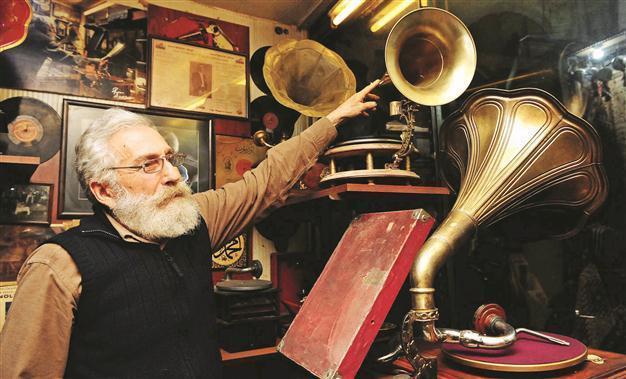Father of gramophones dreams of a museum
ISTANBUL - Anatolia News Agency
 Mehmet Öztekin dedicated his life to repairing and building gramophones in Istanbul’s historic Grand Bazaar and has long dreamed of establishing of a gramophone museum in Turkey.
Mehmet Öztekin dedicated his life to repairing and building gramophones in Istanbul’s historic Grand Bazaar and has long dreamed of establishing of a gramophone museum in Turkey. Öztekin, 70, has been working to open a gramophone museum in order to introduce to future generations this important technology of the past and has long waited for support to make this dream come true. He said he believes a gramophone museum will also make great contributions to Turkey’s cultural heritage.
Öztekin met the magical world of gramophones at age seven in his father’s repair shop. He said the unique musical instrument became an indispensable part of his life and he has been producing and repairing gramophones in his shop at the Grand Bazaar for the last half-century. He has also opened many gramophone exhibitions and invited people into the instrument’s world.
Öztekin told the Anatolian news agency he had discussed the prospects for a gramophone museum with Prime Minister Recep Tayyip Erdoğan at an event last year in the southeastern province of Mardin. Erdoğan asked Mardin’s governor to establish a museum dedicated to gramophones.
He said he believed he had done his best on the issue. “People call me the ‘father of the gramophone’ and they are right. I really am like the father of gramophones; I deal with all of their problems. I try to keep alive gramophones that other people want to get rid of. There are gramophone and record museums all around the world. I have fought to open a museum for years. I spoke with the prime minister; he was very positive on the issue and ordered the [Mardin] governor to establish a museum. But nothing has been done so far.”
Öztekin said he believed a gramophone museum would be a good fit for Mardin, being home to people of all religions and cultures and having unique features.
He said it would not be easy to establish a museum and there needed to be a breadth of gramophones and records displayed in the museum. “My gramophones are not enough for a museum; at least 300 to 500 gramophones are necessary to establish a museum.”
He produced 9,000 gramophones in 38 years
Öztekin said due to great demand, he had started to produce gramophones 38 years ago. He said to produce gramophones’ mechanical features, he needed very technical skills he did not have. That is why he did not produce mechanical parts but instead used those of old gramophones.
He said after the 1980s his gramophones drew great interest and he was sent gramophones to repair, especially from Europe. “During World War I, the gramophone was very popular in the world, but their numbers were limited in Turkey. Because this culture lacked them, gramophones were not treated well in Turkey.”
Öztekin said he produced more than 9,000 gramophones in 38 years and sent them to different parts of the world.
Öztekin said Turkey was the only country where gramophones were repaired in the 1980s, and he had trained many masters, but they became unemployed over time because interest waned in the instrument.
He said he not only trained repairmen but gramophone collectors as well. As a result, more people have started listening to gramophones again. “People used to get rid of gramophones in the past, but now they are searching for gramophones and gramophone records on the Internet and in junk dealers’ shops.”
Öztekin still makes gramophones. “I open my shop at 8:30 every morning just like in the past. Prices for these gramophones vary from 800 to 1,000 Turkish Liras, and they have a one-year guarantee.”
He said although technology had developed, many people under the age of 45 have bought the gramophones he has been producing for the last 40 years.
Key points of using a gramophone
Öztekin said the gramophone needle is a very important factor that gramophone users should give special importance to. “There is friction between the needle and the record. The pin of the needle is soft to avoid damaging the record, because records cannot be repaired. Records are very important to me because first of all, they are a kind of voice documents, and second, they are the best examples of music.”
Öztekin said he keeps 30 gramophones and 2,000 gramophone records at home. “My gramophones are in three categories. First are the ones I have restored; second are the ones I have specially designed and produced; and third are old gramophones. My oldest gramophones date back to 1905, and the most valuable one is a gramophone I made 15 years ago.”
He also said he had produced the world’s smallest gramophone with very good sound quality, which could play big records.
“I repair gramophones to be played, and I do not like when people do not use them. This is a kind of cultural preservation. They should be protected for future generations.”
















